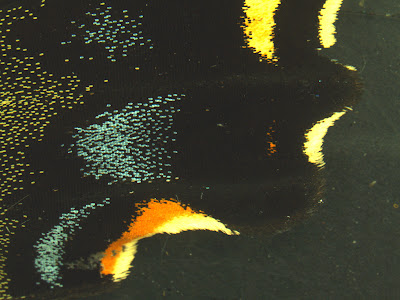Zach found a yellow butterfly in the Che Garden up in Revelle the other day (thus we named the specimen "Yellow Che"), so he brought it into the lab to look at under the microscope. I helped him with the microscope and camera settings so that we could take some cool pictures of what we saw.
The Head
 |
| This is the head of the butterfly. Note the hollowed out cranial cavity (most likely eaten by ants before Zach found the butterfly) and the interesting bug-eyes. |
 |
| The eye resembles a speaker cover. |
 |
| Entering the cranium |
 |
| we can see |
 |
| that if it is focused correctly |
 |
| the camera can photograph the back of the empty head where the brain used to reside |
 |
| There are also those strands of mucus of some sort that are laced across the dead insect's face |
 |
| The antennae are huge compared to the size of the head |
 |
| The antennae are so large they won't fit in the picture. |
 |
| Close up, one can see the many overlapping segments that compose an antenna |
 |
| From the back of the head, one can see where the wings were previously attached (yellow fibrous material) |
 |
| At the right focus, some long connecting pieces of some sort become visible at the lower part of the picture |
The Wings
These ones aren't so good with ranch...
The photos below start out with pictures of the outer part of the wing to give a general idea of the patterns visible to the naked eye.
 |
| The veins and some tiger-striping is evident where the wings attach to the body (lower left-hand corner) |
 |
| Some fancy finning and curves at the wingtips |
 |
| Smatterings of blue and orange coloration |
 |
| Individual scales are visible even at this magnification... |
 |
| ...in addition to some of the sensory "hairs" |
Now we start to zoom in....
 |
| Here you can see some of the topography of the wing, which is not flat by any means, but quite ribbed, especially when it comes down to overlapping scales. |
 |
| The yellow scales kind of fall into one of the veins |
 |
| The black and yellow scales clash |
 |
| A stray blue scale in an all-black area |
 |
| The blue scales are scattered throughout the darkness |
 |
| Some nice pictures of solid yellow scales |
 |
| We wondered what the shiny blue-green stuff was...certainly not scales |
 |
| Checkerboard |
 |
| The four colors in one locale |
 |
| From this angle, the interlocking scales is observable |
 |
| The ridge of one of the ribbings or veins on the wing allowed us to see how the scales just piled on top of each other |
 |
| These sensors, which make it look like the butterfly has hairy wings, help the insect pick up different information about its surroundings. According to Dr. Deheyn, other butterflies can appear to be very very hairy all over with all of their sensors. |
 |
| The nice blue scales refract brightly |
 |
| The bold orange |
 |
| Under some quick accidental fluorescence due to a manual lens slide that was moved to the "Cyan" setting |
 |
| A progression of photos bringing the 3-dimensional array of blue scales into focus one part at a time |
 |
| A progression of photos bringing the 3-dimensional array of orange scales into focus one part at a time |
 |
| It resembles more the tip of a feather than the scaly tip of a butterfly wing |








































































































No comments:
Post a Comment